Review! The Arcade1up Street Fighter Table
Retro-nostalgia is in full force in the market these days; no more is being into old games the domain of just a few people on a message board. And where there’s a market, there’s capitalism trying to fill it. Unlike our last review of the RetroUSB AVS, this is a mass-market product– a nearly-full size cocktail arcade table. How does it stand up to the discerning retrogamer’s eye? Or, if we can’t find one of those, Nicole’s eye?
The Kit
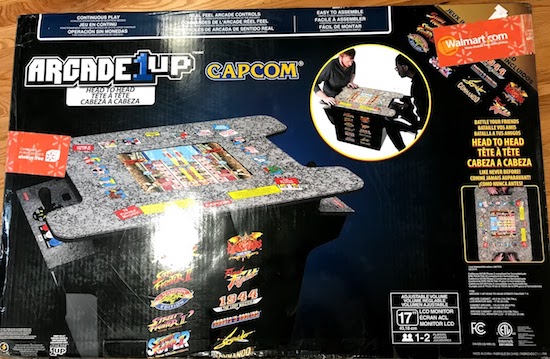
The Arcade1up “Street Fighter Head 2 Head Arcade Gaming Table” is a cocktail arcade machine; a classic form factor that I’ve long felt better lent itself to home usage. After all, standup cabinets are huge, and when not in use just take up space. Tables are always useful!
It’s exactly the form factor that got me interested in this machine. Vintage cocktail cabinets certainly exist, but they’re generally pretty pricy; they were less popular back in the day, so there’s fewer of them around. Many games never made it into a cocktail format; Street Fighter 2 happens to be one of them. Was that a good call by Capcom back in the day? Or is there something to this idea? Let’s find out!
But first, I have to say I find it really funny that Arcade1up advertises as a feature that the system doesn’t require quarters. Who would buy a game at full price and then constantly give more money in order to keep playing? looks at the modern game industry Ah, nevermind.

Assembling the kit
Putting together the kit is very easy; if you’ve ever put together IKEA furniture, you’re pretty much familiar with the process. It is worth noting that clearances are very tight; I often found myself having to unscrew prior steps to get a little more wiggle room. It seems to make for a better end product.
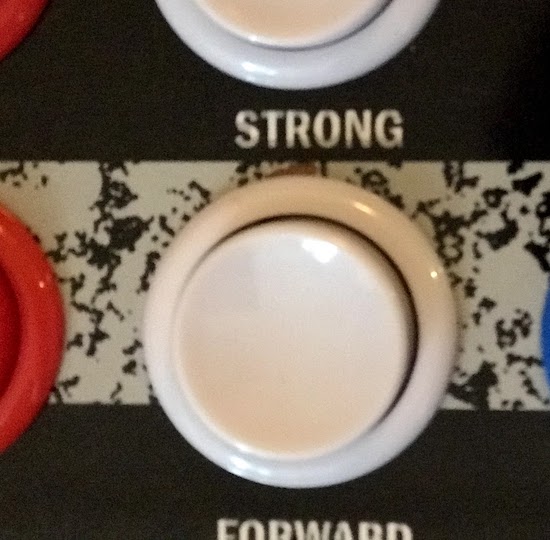
Everything is incredibly aggressively packaged, which definitely seems to have worked, as there was very little damage. However, I did notice one tiny scratch on the control panel, above one of the buttons. This is pictured above; it must have happened prior to packaging as the acrylic “dash protector” that covers the controls doesn’t share it. Not a huge deal, though. Any real Street Fighter cabinet that survived to today is going to have much worse.
Using the unit!
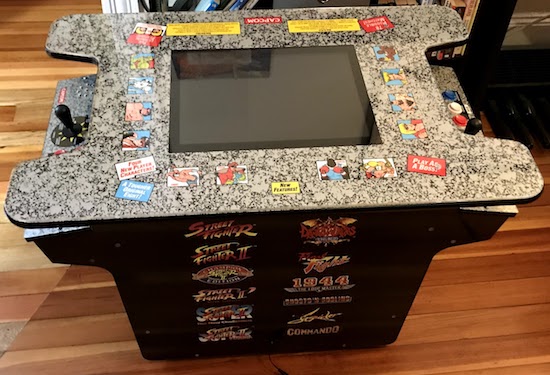
A cocktail arcade cabinet is played sitting; therefore, this machine is actually very close in size to a real machine. It doesn’t come with any stools, but I found a standard folding chair worked just fine to play from. For a good comparison for the height, I took an arcade-stick style controller and put it on my generic living room coffee table. They’re pretty close!
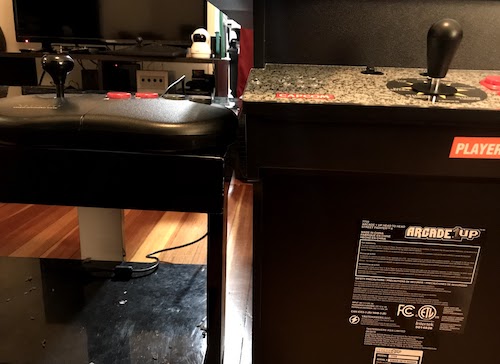
By sheer chance, this Monday I was at an arcade with a work event where they had a full-size original Street Fighter 2 cabinet (which had the Champion Edition board inside). Comparing the controls with that machine, the joysticks are actually pretty close, very clicky and a bit stiff. You can definitely throw a Hadouken.
The buttons on the cocktail table aren’t clicky, though, which is a disappointment. I’m told this is the difference between “Sanwa style” and “Happ style”. In any case, modders haven’t had difficulty changing out buttons on prior models, and if I give this one a try, I’ll make a new blog post.
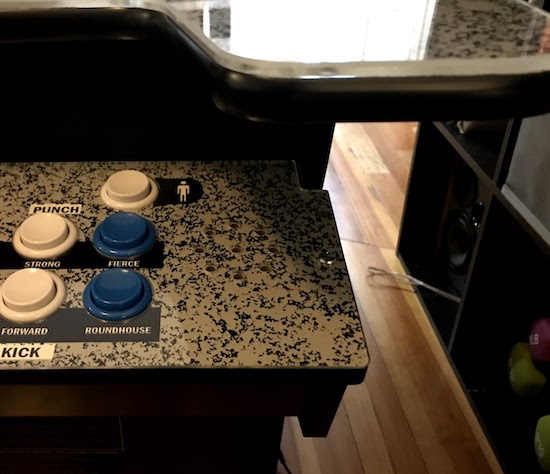
One nice touch is that they put T-moulding on the border around the table level. It looks very nice, and the acrylic tabletop protector is also quite thick. The acrylic protectors on the controls are less thick, and there is no T-moulding, but there’s still a black tape.
I still might cover all the sides in fake wood paneling contact sheets, though.
The Games
The first game I tried was Ghosts ‘N Goblins. It looked and sounded great on the screen; viewing angles aren’t a problem. However, glare definitely will be; the acrylic protective top is very reflective.
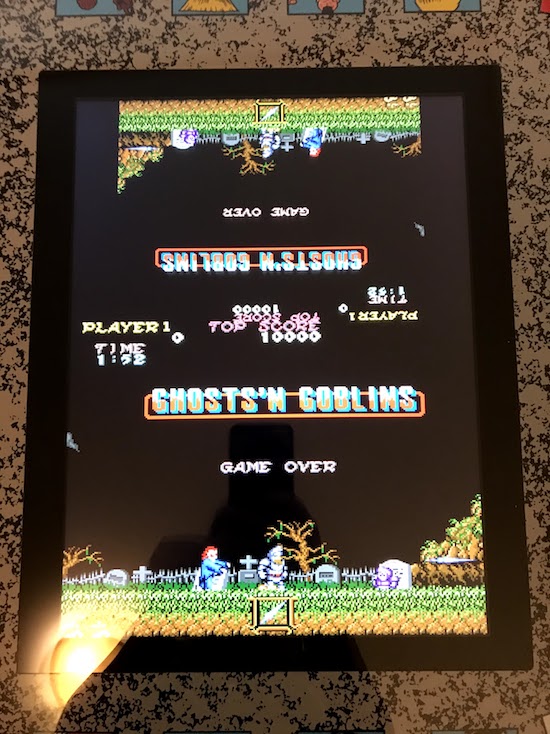
Unlike Street Fighter 2, Ghosts ‘N Goblins is turn-based multiplayer. The gaming table handles this by making the current player’s side larger, and gives the second player a view of what’s going on. It’s pretty neat, as it means your player 2 doesn’t have to look upside-down at your pitiful gameplay.
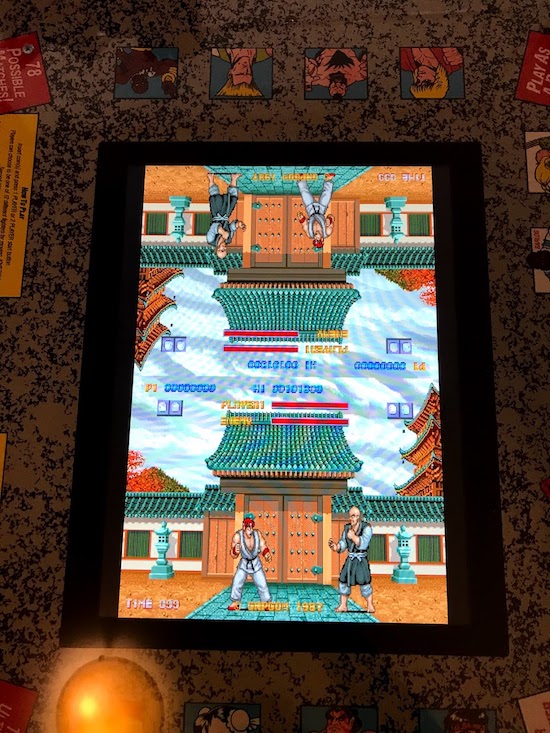
The fighting games, of course, make both characters the same size. To keep the aspect ratio, they do leave some blank space on the screen, but I much prefer that to stretched pixels. It’s worth noting that everything here is stereo with two speakers on each side, connected using standard 3.5mm cables. If you wanted to upgrade the sound, it seems like that’d be one of the easiest mods to do.
Apparently Arcade1up’s standup Street Fighter 2 cabinet only had mono sound, and didn’t mix the channels, just providing one. That’s such a poor decision that I may have returned the table if that was the case here– thankfully, they’ve fixed it.
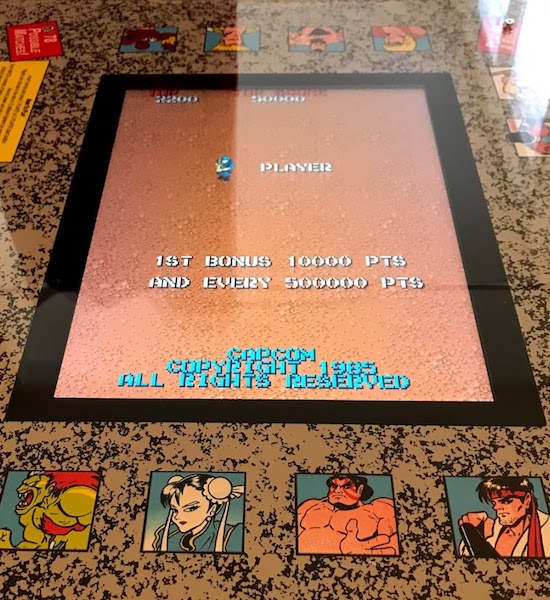
Finally, Commando is the only classical vertical game on the table. It plays great, and might be the sleeper hit of this machine– I hadn’t played it much before but it’s a ton of fun. It just flips the screen between players, like a classic cocktail arcade machine would. But again, you can also see the glare here, and just how reflective the screen is. I have a dark curtain separating my living room and kitchen, and that’s why half the screen is darker than the other side.
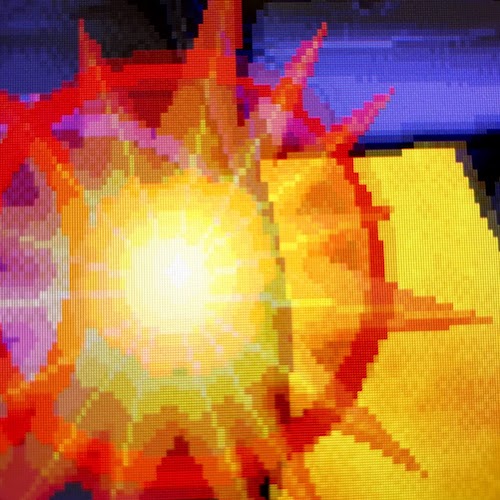
Finally, here’s a closeup of the screen. You can see that they’ve gone for a nearest-neighbor scaling with the pixelated appearance. I like it a lot, but I know some people would prefer the option to have scanlines or a CRT filter.
Last words
This review is being written one the first day I built this, and I haven’t had a chance to try any head-to-head action with another person just yet. Nevertheless, so far my impressions are very positive; I don’t see the need right now to say, replace the innards with a RetroPie machine.
One thing I will say though is that the options are very limited. There is no access to dip switches, emulation view options, or anything of that sort. This is very much a “plug in and play” experience, but it’s always nice to be able to customize things how you wish.
Overall, though, I’m very happy with the table, and for now it has earned its place in my living room. And if I ever get tired of it, past Arcade1up machines have had very active modding communities, so hopefully this one will too.
